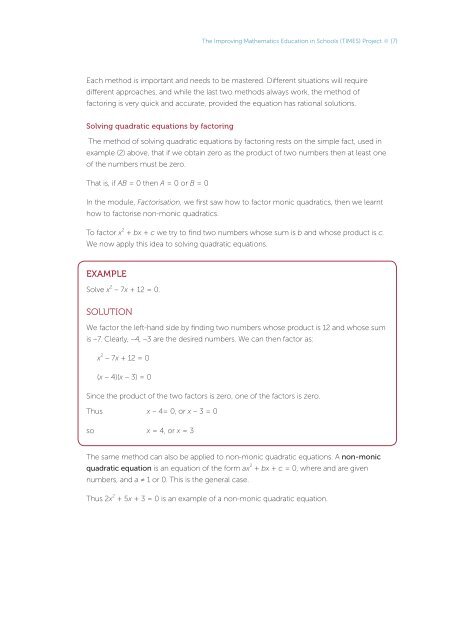quadratic equations - the Australian Mathematical Sciences Institute
quadratic equations - the Australian Mathematical Sciences Institute
quadratic equations - the Australian Mathematical Sciences Institute
- No tags were found...
Create successful ePaper yourself
Turn your PDF publications into a flip-book with our unique Google optimized e-Paper software.
The Improving Ma<strong>the</strong>matics Education in Schools (TIMES) Project{7}Each method is important and needs to be mastered. Different situations will requiredifferent approaches, and while <strong>the</strong> last two methods always work, <strong>the</strong> method offactoring is very quick and accurate, provided <strong>the</strong> equation has rational solutions.Solving <strong>quadratic</strong> <strong>equations</strong> by factoringThe method of solving <strong>quadratic</strong> <strong>equations</strong> by factoring rests on <strong>the</strong> simple fact, used inexample (2) above, that if we obtain zero as <strong>the</strong> product of two numbers <strong>the</strong>n at least oneof <strong>the</strong> numbers must be zero.That is, if AB = 0 <strong>the</strong>n A = 0 or B = 0In <strong>the</strong> module, Factorisation, we first saw how to factor monic <strong>quadratic</strong>s, <strong>the</strong>n we learnthow to factorise non-monic <strong>quadratic</strong>s.To factor x 2 + bx + c we try to find two numbers whose sum is b and whose product is c.We now apply this idea to solving <strong>quadratic</strong> <strong>equations</strong>.EXAMPLESolve x 2 – 7x + 12 = 0.SOLUTIONWe factor <strong>the</strong> left-hand side by finding two numbers whose product is 12 and whose sumis –7. Clearly, –4, –3 are <strong>the</strong> desired numbers. We can <strong>the</strong>n factor as:x 2 – 7x + 12 = 0(x – 4)(x – 3) = 0Since <strong>the</strong> product of <strong>the</strong> two factors is zero, one of <strong>the</strong> factors is zero.Thus x – 4= 0, or x – 3 = 0so x = 4, or x = 3The same method can also be applied to non-monic <strong>quadratic</strong> <strong>equations</strong>. A non-monic<strong>quadratic</strong> equation is an equation of <strong>the</strong> form ax 2 + bx + c = 0, where and are givennumbers, and a ≠ 1 or 0. This is <strong>the</strong> general case.Thus 2x 2 + 5x + 3 = 0 is an example of a non-monic <strong>quadratic</strong> equation.
















